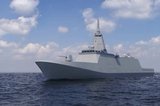FSS suspension indicative of wider push for sovereign naval industry
The UK Government looks to have taken a key suggestion stated in a recent review into the National Shipbuilding Strategy to heart by suspending the Fleet Solid Support (FSS) ship programme, as calls for the build to be given to UK yards increase.
Conducted by Sir John Parker, author of a 2016 report into the country’s national shipbuilding industry which significantly influenced the 2017 strategy document, and published on 4 November, the review centred around the three main procurement naval projects: Type 31 frigates; Type 26 frigates; and FSS ships.
The FSS programme is intended to deliver at least two
Already have an account? Log in
Want to keep reading this article?
More from Naval Warfare
-
![NATO tests use of “undetectable, jam-proof” laser communication in maritime scenarios]()
NATO tests use of “undetectable, jam-proof” laser communication in maritime scenarios
As part of its effort to better prepare its capabilities for operations in contested and congested scenarios, NATO evaluated a Lithuanian ship-to-ship terminal designed to not be susceptible to enemy interference.
-
![Future of the Canadian Patrol Submarine Project is still unclear]()
Future of the Canadian Patrol Submarine Project is still unclear
The Canadian government remains tight-lipped on the timeline and funding required for the next steps of its Canadian Submarine Patrol Project, which should offer improved capabilities for the country’s navy.
-
![Mitsubishi eyes future with Australia’s Mogami selection]()
Mitsubishi eyes future with Australia’s Mogami selection
With Australia’s selection of the Mogami-class for Project Sea 3000, Mitsubishi is investigating local production in the next decade as potential export opportunities emerge.
-
![Thales’ new Sonar 76Nano could equip UK Royal Navy on anti-submarine warfare missions]()
Thales’ new Sonar 76Nano could equip UK Royal Navy on anti-submarine warfare missions
The new sonar is designed to equip uncrewed underwater vessels, with the potential to be used by the Royal Navy for its Atlantic Bastion and Atlantic Net missions.























